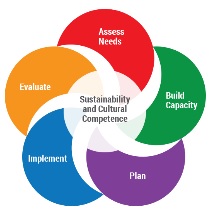Violence Prevention Task Force
|
Define and monitor the problem:
The first step in preventing violence is to understand the “who,” “what,” “when,” “where” and “how” associated with it. This involves analyzing the data from police reports, medical examiner files, vital records, hospital charts, registries, population-based surveys and other sources. Identify risk and protective factors: Understanding what factors protect people or put them at risk for experiencing or perpetrating violence is also important. Risk and protective factors help identify where prevention efforts should be focused. Develop and test prevention strategies: Research data findings from needs assessments, community surveys, stakeholder interviews and focus groups are useful for designing prevention programs. Once programs are implemented, they are evaluated rigorously to determine their effectiveness. Ensure widespread adoption: Once prevention programs have been proven effective, they must be implemented and adopted more broadly. Dissemination techniques to promote widespread adoption include training, networking, technical assistance and evaluation. |
Step 1: Assess Needs: Assess community needs, resources, and readiness to address substance misuse
Step 2: Build Capacity: Focus on identifying resources and readiness for addressing substance misuse in communities Step 3: Plan: Plan effectively by prioritizing risk and protective factors and building logic models Step 4: Implement: Develop action plans to implement the chosen prevention intervention Step 5: Evaluation: Quantifies the challenges and successes of implementing a prevention program |
Violence Prevention Steering Committee
|
Bronson Hospital
Amy Terry, System Director Comm. Health & Grants City of Kalamazoo City of Kalamazoo Department of Public Safety Jeffrey Hadley, Chief Donald Webster, Deputy Chief City of Portage Pete Strazdas, Mayor City of Portage Public Safety Nick Armold, Deputy Chief Community Mental Health & Substance Abuse Services Dave Ray, Manager, Provider Network Services Eastside Neighborhood & Habitat for Humanity Edison Neighborhood Tammy Taylor, Executive Director Family and Children Services Diane Marquess, Behavioral Health Services Director Gyphon Place Maricela Alcala, CEO Lacee Lyons, COO Amy Dunham, School Programs Director Hispanic American Council Adrian Vazquez, Interim Executive Director Kalamazoo Child Abuse and Neglect Prevention Council Sarah Joshi, Executive Director Kalamazoo Community Foundation Sholanna Lewis, Community Investment Manager Kalamazoo County Health Department Angela Anderson, Community Education Coordinator Kalamazoo County Prosecutor Jeff Getting, Prosecutor |
Kalamazoo County Sheriff
Rick Fuller, Sheriff Kalamazoo Regional Educational Services Agency Dr. Margie McGlinchey, Asst. Superintendent for Instruction Nkenge Bergan, Director of Student Services, KPS Kalamazoo Strong Organization Rachel Kaiser Northside Ministerial Alliance Dr. Addis Moore, President, Mt. Zion Baptist Rev. Lenzy Bell, Vice President, First United Baptist Prevention Works, Inc. Danielle Sielatycki, Executive Director Amy Slancik, Director of Health Network Strategies Senator Margaret O’Brien , 20 th State Senate District Megan Hicks, District Director Southwest Michigan Behavioral Health Mindie Smith Anne Wickham, Director of Operation Southwest Michigan First Keith Kehlert, Director United Way of the Battle Creek and Kalamazoo Region Mike Larson, President & CEO Robert Elchert, Community Impact Associate Western Michigan University Chief Scott Merlo, Director of Public Safety YWCA Grace Lubwama, CEO Sherry Brockway, Director of Training & Community Impact Cathy Brown, Director of Victim Services Jessica Glynn, Senior Director of Law & Policy |






